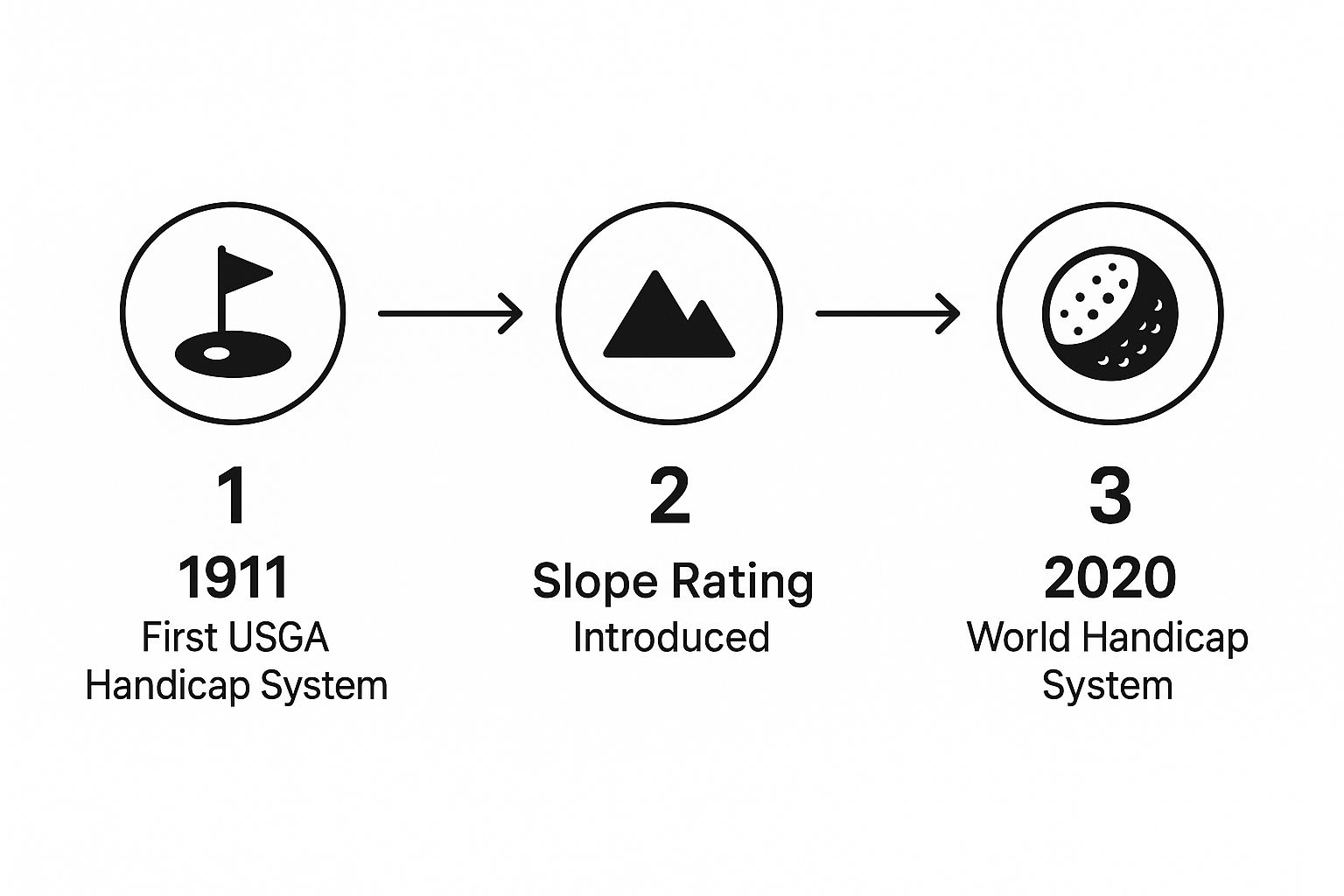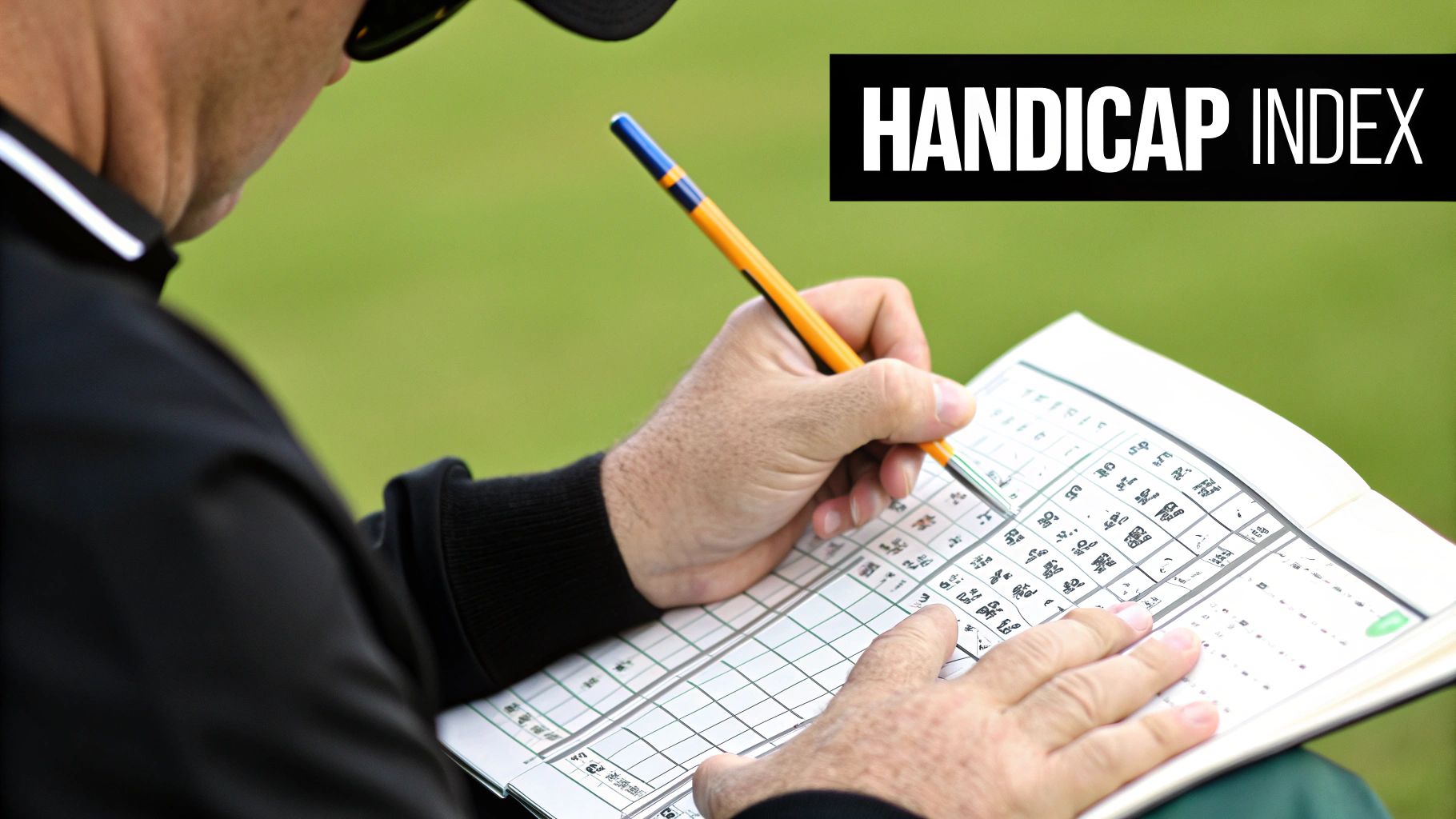When people talk about having the "best handicap" in golf, it's easy to get the wrong idea. It's not about chasing a specific number or trying to get as close to zero as possible. Instead, it’s about having a fair number—one that genuinely reflects your game and lets you compete on a level playing field with anyone, anywhere.
The whole point is to use the World Handicap System (WHS) to track your real progress and make every round you play more meaningful. Think of it as your personal performance benchmark, a true measure of your potential.
Understanding What "Best Handicap Golf" Actually Means

Many golfers fall into the trap of thinking a "good" handicap is a low one. While a scratch golfer (with a handicap of 0) is obviously a fantastic player, that’s not the ultimate goal of the system itself. The system is designed to give an honest, accurate picture of your demonstrated ability so you can have a fair match against any other golfer.
It's helpful to think of your handicap not as a grade on a report card, but as a translator. It takes your raw scores from any course and translates them into a universal language that accounts for the difficulty of where you played. This is why shooting a 90 at a notoriously tough course feels—and is treated—completely different than shooting a 90 at your easy local muni.
The Core Components of a Fair Handicap
So, how does this "translation" work? It all comes down to two critical numbers that every golf course is given: the Course Rating and the Slope Rating.
-
Course Rating: This number is a baseline. It estimates what a scratch golfer would likely shoot on that course on an average day. If a course has a rating of 72.1, it means a top-tier player is expected to shoot just a hair over par.
-
Slope Rating: This one is all about relative difficulty. It measures how much harder a course is for a "bogey golfer" (someone who averages around 90) compared to a scratch golfer. A higher slope, like 135, signals that the course is significantly tougher for the average player.
These two ratings work together to ensure your handicap is portable and fair, whether you're playing at home or on a championship course during a vacation. They are the engine that makes the whole system equitable.
To get a better handle on these concepts, here's a quick breakdown of the terms you'll see all the time when dealing with your handicap.
Key Handicap Terms and What They Mean for You
This table is a quick reference guide to help you immediately grasp the core concepts that affect your game.
| Term | How It Impacts Your Handicap |
|---|---|
| Handicap Index | Your official, portable number that represents your potential playing ability. It's the number you take with you from course to course. |
| Course Handicap | The actual number of strokes you receive for a specific course, calculated using your Handicap Index and the course's Slope Rating. |
| Course Rating | The baseline score expected from a scratch golfer. A higher number means a tougher course, even for the pros. |
| Slope Rating | Measures how much more difficult a course is for a bogey golfer versus a scratch golfer. A higher slope means more strokes for you. |
| Score Differential | A calculation that turns your score on a given day into a standardized value, factoring in the Course and Slope Ratings. Your best differentials determine your Handicap Index. |
Understanding these terms is the first step to truly owning your handicap and using it to your advantage. They're the building blocks of a fair and competitive game for everyone.
The real power of the WHS is its ability to turn a subjective performance into an objective, comparable metric. It removes the guesswork and provides a standardized measure of potential that makes competition exciting and equitable for everyone involved.
The World Handicap System in Action
Rolled out globally in 2020 by the USGA and R&A, the WHS unified various handicapping systems into one universal standard. It calculates your Handicap Index by averaging the best eight of your most recent 20 "score differentials."
This modern, more responsive system has encouraged massive participation. Today, over 3.2 million golfers in the U.S. maintain an active handicap index. If you're curious about how we got here, it's worth taking a look at the history of golf handicapping to see just how far the game has come.
The Journey to a Fairer Game of Golf
To really get a feel for how accurate and fair today's handicap system is, it helps to look back at where it all started. The idea of leveling the playing field in golf isn't new—it's been a century-long quest, evolving from informal club-by-club rules to the unified global standard we have today. This whole journey has been about one thing: creating the best handicap golf experience for every amateur out there.
This evolution has been full of major turning points. The very first official system was rolled out by the USGA way back in 1911, and it was a pretty simple "three-score average" method borrowed from Britain. It was a good start, but it quickly became clear that it needed some tweaking to account for the huge differences in course difficulty from one club to the next. You can take a deeper dive into this history over at Keiser University's College of Golf.
Key Milestones in Handicapping
Getting from that basic system to the modern WHS involved some real game-changing moments. Each step brought golfers closer to a truly fair measurement of their ability.
A huge breakthrough came in the 1980s with the introduction of the Slope Rating. This was a massive leap forward because, for the first time, a system could mathematically figure out how much tougher a course plays for an average golfer compared to a scratch player. This single innovation made handicaps far more portable and, more importantly, much more accurate.
This infographic breaks down the key moments in the evolution of golf handicapping.

As you can see, the progression is clear—from a simple, local approach to the sophisticated, worldwide standard we rely on today, the WHS.
The Modern Standard
The final major piece of the puzzle fell into place in 2020 with the launch of the World Handicap System. This system pulled together all the previous advancements, like Course and Slope Ratings, into one seamless, cohesive standard for the entire golfing world.
This unified approach makes everything simpler. It means a golfer from the United States can compete on fair terms against a player from Scotland or Japan without needing a calculator to do complex conversions. Understanding this history builds a lot of confidence in the WHS, proving it's the most credible and advanced tool ever created for amateur competition. This kind of standardization is also a big deal behind the scenes, where effective golf course management strategies to boost your club depend on consistent and reliable data.
The World Handicap System represents the culmination of over a century of learning. It’s not just an update; it’s a global promise of fairness, ensuring every golfer has an equal chance to compete and improve, no matter where they play.
How Your Handicap Index Is Calculated

It can feel a little like black magic when your scores from all sorts of different courses and weather conditions get boiled down to a single number—your Handicap Index. But it’s not magic at all. It's a surprisingly logical system designed to find the truest measure of your potential.
The system’s brilliance lies in its ability to standardize every round you play. This makes it possible to fairly compare an 85 at a tough track like Pebble Beach to a 95 at your friendly local muni. The entire calculation starts by turning your raw score into what’s called a Score Differential. This is the key that unlocks a fair and accurate handicap.
From Your Scorecard to a Score Differential
Think of a Score Differential as your "adjusted" score for the day. It’s the system's way of leveling the playing field by factoring in the specific challenge of the course you just played. To figure it out, you just need three key pieces of info from your round.
- Adjusted Gross Score: This is your total stroke count for the round, but with a cap on any disaster holes, as set by the World Handicap System (WHS).
- Course Rating: This number tells you what a scratch golfer is expected to shoot on that course.
- Slope Rating: This reflects how much more difficult the course is for a bogey golfer compared to a scratch golfer.
The formula chews on these numbers and spits out your Score Differential for that specific round. A lower differential means you played better relative to the course's difficulty. Getting this number right is the most crucial first step.
The whole point of the Score Differential is to answer one simple question: "How well did you actually play today, considering how tough the course was?" It puts every round on equal footing, so a great day on a monster course gets the credit it deserves.
This conversion makes sure every score you post is a fair, comparable piece of data that helps build your real handicap profile.
Finding Your Best Eight Rounds
Once you’ve logged at least 20 scores, the World Handicap System starts looking for your true potential. It doesn’t just average everything—that would mix in your best days with your worst, giving a skewed picture of your ability. Instead, it hunts for a pattern of your best performances.
The system singles out the eight lowest Score Differentials from your most recent 20 rounds. This is a critical detail. It intentionally tosses out your 12 higher-scoring rounds, focusing only on the scores that show what you're capable of when you're playing well.
This "best 8 of 20" approach is what makes your Handicap Index a measure of your potential ability, not just your average day on the course. It’s what makes the system aspirational. It rewards consistency but understands that nobody plays their best golf every single time out.
The Final Calculation Averages Your Best
After the system has pinpointed your eight best Score Differentials, the last step is incredibly simple: it just calculates the average of those eight numbers. The result is your official Handicap Index.
Let's walk through a quick example to see it in action.
- Post 20 Scores: You play 20 rounds, and each one gets converted into a Score Differential.
- Identify the Best 8: The system finds your eight lowest differentials. Let's imagine they are: 18.2, 19.5, 20.1, 17.8, 21.0, 19.8, 20.5, and 18.7.
- Calculate the Average: Add these eight numbers together, which gives you 155.6.
- Finalize the Index: Divide that sum by 8, and you get 19.45. This figure is then rounded to one decimal place, making your official Handicap Index 19.5.
Because the index is a rolling average, it's constantly updating as you post new scores. Every new round you enter pushes out the oldest of the 20, ensuring your handicap always provides a current, dynamic reflection of your game.
Using Your Handicap to Actually Improve
Your handicap is so much more than a number to settle bets on the first tee. Think of it as your personal golf coach—a brutally honest diagnostic tool that tells you exactly where your game stands. When you learn how to use it right, it stops being a static number and becomes a dynamic roadmap for real, measurable improvement.
Too many players see their handicap tick up or down but never dig into the why. The secret to playing great handicap golf is to stop obsessing over the final number and start analyzing the data behind it. Treat your handicap not as a final grade, but as a guide to becoming a smarter, more efficient golfer.
Analyze Your Game Like a Pro
The first step is to become a detective of your own game. You can’t fix what you don’t measure, right? Start tracking key stats that go beyond just your total score. The data from your rounds will quickly reveal patterns that pinpoint exactly where you're bleeding strokes.
When you stack your numbers up against scratch golfers, the path forward becomes crystal clear. For instance, scratch players hit roughly 55-60% of fairways and average around 10-11 greens in regulation per round. They also get up and down to save par about 50% of the time they miss a green.
By tracking your own performance in these areas, you'll see exactly where you stand. Is your driver costing you shots off the tee? Or is the game falling apart around the greens? The data gives you answers that guesswork never will.
Your handicap tells a story. Every fluctuation is a chapter revealing your strengths and weaknesses. Learning to read that story is the first step toward writing a better ending for your next round.
Once you know where the leaks are, you can build a practice plan that directly plugs them. No more random range sessions. It’s time for purposeful practice.
To get started, you need a clear framework for turning your handicap data into a concrete plan. This isn't just about spotting weaknesses; it's about creating a systematic approach to fixing them.
Your Handicap-Driven Improvement Plan
| Handicap Insight | Actionable Strategy | How to Track Your Progress |
|---|---|---|
| High number of double bogeys (or worse) | Focus on course management. Aim to eliminate penalty strokes and "hero shots." Play for the center of the green and avoid sucker pins. | Keep a "blow-up hole" tally. Your goal is to reduce this number by 50% over your next 10 rounds. |
| Low Greens in Regulation (GIR) Percentage | Dedicate 70% of your practice time to your approach shots (100-175 yards). Work on distance control and hitting specific targets on the range. | Track your GIR percentage in a golf app or notebook. Aim for a 10% improvement in the next two months. |
| More than 36 putts per round | Practice lag putting and short putts (3-6 feet). The goal is to eliminate three-putts. Spend 20 minutes on the putting green before every round. | Chart your total putts per round and, more importantly, the number of three-putts. Aim for under two three-putts per round. |
| Low Fairway Hit Percentage | Prioritize finding the fairway over pure distance. Consider using a 3-wood or hybrid off the tee on tight holes. Work on a consistent, repeatable pre-shot routine. | Record your fairways hit each round. Set a realistic goal to increase this by 15% over the season. |
This table isn't just a list of tips—it's a new way of thinking. It connects the what (the problem your handicap reveals) with the how (the specific actions you'll take) and the proof (the metric you'll watch).
Set Smarter, Achievable Goals
With a clear picture of your weaknesses, you can finally set goals that are both ambitious and realistic. Forget vague wishes like "get better." Use your handicap data to create specific, measurable targets. A great starting point is aiming to lower your Handicap Index by two full points over a season.
This kind of concrete goal gives your practice a laser focus. It turns every ball on the range and every drill on the putting green into a deliberate step toward a tangible outcome.
- Weakness: Poor Driving Accuracy. Your goal is to increase your fairways hit percentage by 10% over the next three months.
- Weakness: Inconsistent Short Game. Aim to reduce your three-putts to less than two per round and boost your up-and-down percentage.
- Weakness: Penalty Strokes. Focus on smarter course management to cut your penalty strokes in half over your next ten rounds.
This targeted approach ensures your hard work actually translates into a lower handicap, creating a positive feedback loop that builds incredible momentum.
Use Your Handicap on the Course
Your handicap isn't just for practice; it’s a strategic weapon you should be using every single round. One of the most practical applications is simply choosing the right tees. Playing from a set of tees that matches your ability makes the game infinitely more enjoyable and gives you a real chance to score well, which leads to more accurate handicap data.
Beyond that, your Course Handicap—the number of strokes you get on a specific course—should actively guide your strategy. If you get a stroke on a brutal par-4, playing for a bogey is a brilliant strategic move. Don't let your ego trick you into a risky hero shot when a safe play all but guarantees a net par. This is the mindset of a smart golfer.
As you play more, you might find that walking the course helps you think more clearly about these decisions. In fact, many players discover there are countless benefits of walking a golf course that contribute directly to a better mental game.
How Tour Professionals Compare to Amateurs

To really get a feel for the handicap system and what your own progress means, it helps to glance at the very top of the sport. While pros on tours like the PGA don’t keep an official Handicap Index for tournaments, we can figure out what their index would be. The numbers are nothing short of incredible, and they shine a bright light on the skill gap separating them from even the very best amateurs.
This isn’t meant to be a downer. Just the opposite, actually. It’s a great way to set realistic expectations for your own game and appreciate the insane talent at the highest level. It helps connect your personal golf journey to the bigger picture and shows just how well the handicap system works to level the playing field for the rest of us.
Understanding the Plus Handicap
When a golfer’s handicap drops below zero, they’ve entered some pretty special territory known as a "plus handicap." This means a player is so good that they’re expected to shoot under the Course Rating consistently. A golfer with a +2 handicap, for instance, has to shoot two-under-par just to “play to their handicap.”
Think of it like this: for most of us, the handicap system gives us strokes to help us get to par. For plus-handicap players, the system actually adds strokes to their score to bring them back up to par. It’s the calling card of a seriously skilled and consistent golfer.
A plus handicap means a player has gone beyond just competing against the course—they’re now consistently beating it. It's the standard for elite amateurs and every single professional golfer.
The Staggering Numbers of the Pros
So, just how good are we talking? Studies have shown that the average PGA Tour player would carry a Handicap Index of +5.4. And some of the game’s biggest names post numbers that are even more wild. Top players like Dustin Johnson and Jordan Spieth have floated around a +6.5 average, while Rickie Fowler has been calculated as low as a mind-boggling +8.4. You can find some great insights into how professional golfer handicaps are calculated to learn more.
These numbers are almost tough to wrap your head around. A player with a +6 handicap is expected to average six shots better than a scratch golfer on any given course. It’s this machine-like consistency that truly separates them from the amateur world, where only about 1.85% of male golfers ever manage to become a scratch player, let alone a plus one.
What This Comparison Means for Your Game
Seeing these wild numbers gives you some valuable context for your own handicap. It shows that getting to a single-digit handicap is a huge accomplishment, and becoming a scratch golfer puts you in a tiny, elite club of players around the world.
Use this knowledge to set goals that make sense for you and to celebrate your progress along the way. Your journey in handicap golf isn't about trying to match a tour pro; it's about competing against yourself and using a fair system to see how far you’ve come. Every single point you knock off your index is proof of your hard work and love for the game.
Making Golf Accessible for Every Player
At its heart, golf is about bringing people together. The handicap system is what makes that possible. While most people think of it as just a way to level the playing field between players of different skill levels, its biggest impact is arguably in the world of adaptive golf. This is where the idea of "best handicap golf" truly comes alive—creating a system that opens its arms to every single player, no matter their physical ability.
This is exactly where the World Handicap System (WHS) shines. It's not just a rigid set of rules for crunching numbers; it’s a flexible framework designed to make the game fair for everyone. For players with physical disabilities, the game might look a little different, but the goal is still the same: to compete, enjoy the challenge, and connect with others out on the course.
Integrating Adaptive Equipment and Rules
The WHS was built to accommodate modified equipment and assistive technologies. These tools aren’t about gaining an unfair advantage—they’re about making participation possible. From single-rider carts that help a golfer stand for a swing to specialized clubs made for one-armed players, the focus is always on access.
The rules of golf for players with disabilities are founded on this same principle. They offer modifications that let the game be played without changing its core challenge. For instance, a player who can't take a stance in a bunker might be allowed relief, making sure the penalty is fair without being impossible to overcome.
The goal of adaptive golf rules isn't to make the game easier, but to make it possible. It’s about removing barriers so that a player's score reflects their golfing skill, not their physical limitations.
This smart integration means a player using adaptive equipment can still hold a legitimate Handicap Index, letting them compete fairly in any club tournament or weekend match.
Leveling the Playing Field for All Abilities
So, how does it all work? The handicap system measures a player's demonstrated ability against the difficulty of the course. For an adaptive golfer, this process is exactly the same. They post their scores, a Score Differential is calculated, and their Handicap Index is set based on their best rounds.
It’s a beautifully simple system that means a player using a specialized cart and another walking the course can compete on totally equal footing. Their handicaps reflect their potential scoring ability, creating a truly level playing field. It's a celebration of the skill, strategy, and pure grit of every individual.
This inclusive approach is what will keep the sport growing. It proves that golf really is a game for life, ready to adapt to whatever physical circumstances we face. The equipment itself is a massive part of this, and technology is breaking down barriers every day. You can see a full range of what’s out there in our guide to the top adaptive golf equipment for 2025.
In the end, the WHS makes sure the competition is about making great shots and managing the course. It lets the story of the round be about a perfectly struck iron or a putt that was read just right—not about the challenges a player faces before they even step up to the ball. That’s what a fair and inclusive game is all about.
Common Handicap Questions Answered
Diving into the world of golf handicaps can feel a bit like learning a new language. The World Handicap System (WHS) is built to be fair and straightforward, but let's be honest, a few questions always seem to pop up for both new golfers and seasoned players.
Getting a handle on these key points is the best way to use your handicap with confidence. So, let's clear up some of the most common questions and get you on the right track.
How Many Rounds Do I Need for a Handicap?
This is usually the first question on everyone's mind. To get an official Handicap Index, you need to post a minimum number of scores, but it's probably fewer than you think.
While the WHS calculation uses the best eight of your last 20 rounds, you don't need a full 20 to get started. You can get your initial Handicap Index after submitting scores for just 54 holes. That can be any mix of 9-hole or 18-hole rounds.
This low barrier to entry is fantastic because it lets new players get an official index quickly. You can jump into club events and competitions almost right away.
Do I Have to Post Every Single Score?
In a word, yes. This is a big one, and it's all about keeping the game fair for everyone. The integrity of the entire system hinges on players posting all their acceptable scores—the good, the bad, and the ugly.
When you post everything, your Handicap Index becomes a true reflection of your potential ability. If you start cherry-picking only your best rounds or "forgetting" to post a high score, it undermines the fairness of the game for you and everyone you play with.
To keep things fair and your handicap accurate, the rule is simple: if you play a round under the Rules of Golf, you post the score. Honesty is the bedrock of the handicap system.
How Does the System Handle a Really Bad Hole?
We've all been there. That one blow-up hole that sends your scorecard into a tailspin. Thankfully, the WHS has a built-in safety net to stop one disastrous hole from wrecking your handicap.
It's called Net Double Bogey, and it puts a cap on the maximum score you can take on any hole for handicap purposes. Your max score is calculated as: Par + 2 + any handicap strokes you get on that hole.
For example, say you're a 20-handicap playing a par-4 where you get one stroke. Your maximum score for that hole is 7 (which is 4 for par + 2 for double bogey + 1 stroke). Even if you took a 9 or 10, you'd only record a 7 for your handicap calculation. This keeps one bad hole from throwing your entire handicap out of whack.
At Caddie Wheel, we believe golf should be more accessible and enjoyable for every player. Our motorized wheel attachment lets you walk the course without the strain, so you can focus on your game and post those great scores. Experience the freedom of an effortless round at https://caddiewheel.com.


Share:
Electric Push Carts Reviews Golf A Buyer's Guide
Choosing Your Golf Cart Bag Cooler Guide